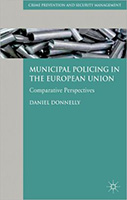Municipal Policing in the European Union: Comparative Perspectives

Author: Daniel Donnelly
Publisher: Houndmills, Basingstoke, Hampshire, UK: Palgrave Macmillan, 2013. 240p.
Reviewer : Thomas Feltes | January 2014
After his book “Municipal Policing in Scotland” (2008), in which the author examined the contemporary model of municipal policing in modern day Scotland and looked at the role of community policing, private sector involvement, surveillance and CCTV, the role of police authorities, police governance and accountability, Daniel Donnelly perhaps thought that it would be meaningful and necessary to study municipal policing in the European Union as well. But what is called the “European Union” is neither a country, a confederation, nor even a unique enterprise, and especially in terms of policing, the situation is somewhere between diverse and messy. The reasons are manifold, and usually one needs more than 200 pages alone to explain to non-Europeans the complex reasons of why this is the case and what the consequences are for policing and crime fighting.
So, the undertaking of Donelly to explain municipal policing in the European Union is on the one hand brave, but also pointless on the other, because there are no overall theories or developments that can be described. Just compare the history of policing in France, Germany, Italy and Spain, and you very soon realize why this is the case. Donelly himself seemed to realize this during his writing, and as a consequence of that, the book is more about community policing and other aspects such asprivate security, police and politics, and finally democratic policing (whatever this means) than municipal policing. But here again, pitfalls arise. Too many books and articles have already been published on community policing in Europe and elsewhere, showing that the definition alone is not unique, and that the understanding of community policing varies a lot between police forces, making even a basic theory of community policing unavailable. Nevertheless, Donelly provides us with the impression (e.g. on page 62) that there is such a clear and comparable definition of community policing. Finally, Donelly ends up with describing what police in a city are doing – though that seems to be missing the basic questions of whether municipal policing is in competition with state or federal policing, what the advantages and disadvantages of the different types of policing are, and how these are rooted in the history of European countries. Additionally, just three out of the more than 200 pages deal with Eastern Europe – so the book is clearly more about policing in cities in western European countries.
What is the advantage of the book? It gives those who are not familiar with the European systems (not system!) of policing a basic and very rough overview. Not more, but not less. The book is more about different forms of everyday policing than a systematic analysis of policing structures. What the publisher says on his website is a little bit too far ranging: “Municipal Policing in Europe provides an exclusive vista of the evolving model of local policing in the EU member states at a time when police forces are increasingly collaborating together.” Unfortunately, this is not really the case.
Professor Dr. Thomas Feltes, Department of Criminology and Police Science, Ruhr University Bochum, Germany www.police-newsletter.com


